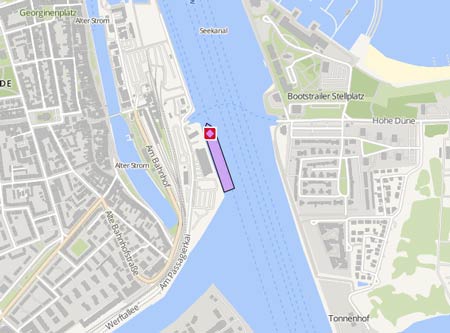SPARTA IV
Course/Position
Latest ports
Latest Waypoints
Latest news
Russian military convoy shadowed during transit through waters of NATO countries
A Russian naval force consisting of four ships was close to rounding Skagen Reef on the afternoon of March 19, 2025, heading towards the Great Belt. The Royal Navy, along with NATO allies, had conducted a coordinated operation to monitor the Russian naval task group since entering the English Channel on March 16. The Type 23 frigate HMS 'Somerset', the minehunter HMS 'Cattistock' and the RFA 'Tidesurge' had participated in the monitoring operation, which began south of Portsmouth. The operation involved both naval assets and aerial surveillance, including a RAF P8 Poseidon maritime patrol aircraft from RAF Lossiemouth. The ships were on their way back from Syria, where they have picked up military equipment that is no longer needed after the Russian-backed President Assad's regime fell in Dec 2024. The ships have been continuously shadowed by aircraft and warships from the NATO countries they have passed, a task that was taken over by units from the Danish Navy when the naval force have passed Skagen. The convoy consisted of the destroyer 'Severomorsk', the landing craft 'Aleksandr Shabalin', and the cargo ships 'Sparta IV' and 'Siyanie Severa', both of which sailing for the Russian Navy. The naval force was on its way to St. Petersburg with the 'SParta IV' having an ETA as of March 24, where equipment from Syria has previously been brought ashore. The Russians are negotiating with the new rulers in Syria for permission to continue using the strategically important naval base in Tartus. The Russians are prepared to pay for the base with Russian oil. The status of these negotiations was unknown. Report with photos: https://www.royalnavy.mod.uk/news/2025/march/19/250319-royal-navy-shadow-russian-task-group-returning-from-syria-in-the-channel
Russia continues to transport military equipment back from Syria
The 'Sparta IV' is heading to the port of Tartus to pick up military equipment left behind by the Russians after the fall of Bashar al-Assad's regime anid is actually destined to Port Said with an ETA as of Fe 12, 2025. The military equipment transported by Russian cargo vessels will significantly bolster the Kremlin's supplies, which the ongoing war in Ukraine has seriously depleted. On the morning of Feb 8, several Russian container ships carrying weapons taken from Syria departed the Mediterranean Sea and entered the Atlantic Ocean, traveling north along the western coast of Portugal. They were accompanied by the landing ships 'Ivan Grien' and 'Aleksandr Otrakovsky' and the tanker 'General Skobielev'. In the Atlantic, the fleet was joined by the British fast patrol boat HMS 'Cutlass', which was responsible for protecting the waters around Gibraltar. The two Russian frigates 'Admiral Grigorovich' and 'Admiral Golovko', which had been assisting Sparta and Sparta II since they left Syrian waters on Jan 27, were not seen in the Atlantic. Their absence may indicate that they have turned around and are now escorting the 'Sparta IV', and once loaded, they will probably accompany it westward to save it from the fate of the 'Ursa Major', which sank off the coast of Oran, Algeria, on Dec 23 following an explosion. For two months, the Russian Navy tanker 'Yelnya' had been stationed off the coast of Algeria, waiting for two ships, and likely refueled these on Feb 6, allowing them to reach Syria. The Russian convoy navigating the Mediterranean was under constant surveillance by NATO aircraft and drones. It was likely shadowed alternately by two nuclear-powered submarines: the American USS 'Indiana' and the British HMS 'Anson'. These submarines made several trips back and forth through the Strait of Gibraltar in Jan and Feb.
Russian convoy shadowed by NATO forces
On May 23, 2024, the 'Sparta IV', along with the corvette 'Orekhovo-Zuyevo', the landing ships 'Ivan Gren' and 'Aleksandr Ortakovskiy', the surveillance ship 'Kildin' and the fleet tanker 'Kama' were observed during the transit of the Baltic Sea. The Russian Navy was withdrawing units from the Mediterranean. On May 25 anbd May 26 NATO and Federal Police units were deployed to monitor the transit of the five Russian warships along with the freighter to Russian bases in Northern Europe. The missile corvette was relocated from the Black Sea to the Mediterranean in January 2021 and has to be overhauled after three years in Tartus. The convoy has been shadowed by several NATO ships since the start of May. In the North Sea, the Dutch corvette 'Holland' as well as the British patrol ship "Tyne" and the Belgian patrol boat "Castor". The convoy used the so-called Exclusive Economic Zones (EEZ) of the North Sea states, where an internationally agreed right of free passage applies. The "Kildin", the "Sparta IV" and the "Orekhovo-Zuevo" sailed through the Great Belt and the Fehmarn Belt into the Baltic Sea on May 25. Along German territorial waters, the Federal Police monitored the Russian ships with the "Bayreuth" and "Neustadt". The "Sparta IV" had loaded military supplies from Syria for Baltiysk, the military port of the Kaliningrad Oblast. For the heavy-lift ship, this is already the second trip with military supplies from Syria to Kaliningrad. The two landing ships and the tanker are still in the North Sea. They are expected to continue to their home port on the Kolafjord near Murmansk during the week. It is not known what the ships are loaded with. The reason for the units' long journey is the Russian Navy's lack of shipyard capacity in Syria. There are no docks for its units in the Mediterranean. Photos: https://x.com/kon_marine/status/1793650665740534179
Upload News

